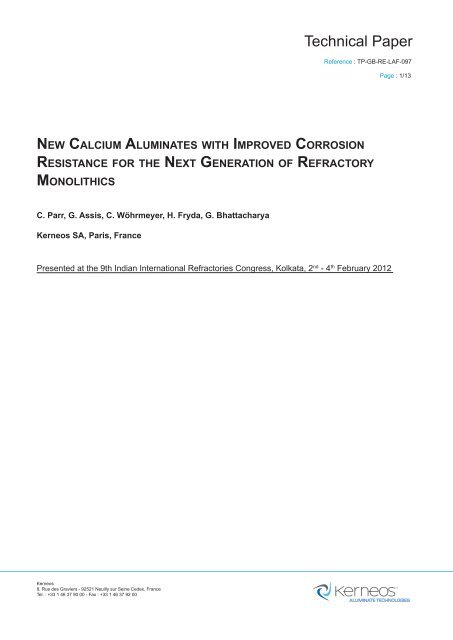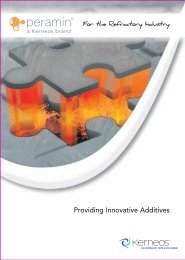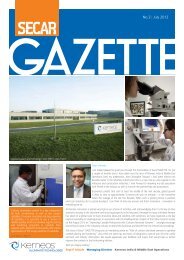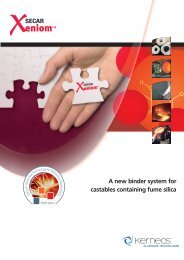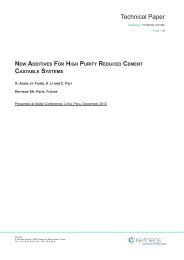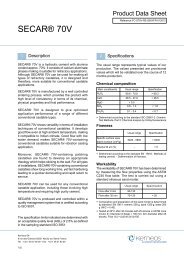Download the document - SECAR®, solutions for refractories
Download the document - SECAR®, solutions for refractories
Download the document - SECAR®, solutions for refractories
You also want an ePaper? Increase the reach of your titles
YUMPU automatically turns print PDFs into web optimized ePapers that Google loves.
Technical Paper<br />
Reference : TP-GB-RE-LAF-097<br />
Page : 1/13<br />
New Calcium Aluminates with Improved Corrosion<br />
Resistance <strong>for</strong> <strong>the</strong> Next Generation of Refractory<br />
Monolithics<br />
C. Parr, G. Assis, C. Wöhrmeyer, H. Fryda, G. Bhattacharya<br />
Kerneos SA, Paris, France<br />
Presented at <strong>the</strong> 9th Indian International Refractories Congress, Kolkata, 2 nd - 4 th February 2012<br />
Kerneos<br />
8, Rue des Graviers - 92521 Neuilly sur Seine Cedex, France<br />
Tel. : +33 1 46 37 90 00 - Fax : +33 1 46 37 92 00
Technical Paper<br />
Reference : TP-GB-RE-LAF-097<br />
Page : 2/13<br />
ABSTRACT<br />
By changing <strong>the</strong> microstructure of a monolithic castable it is possible to enhance <strong>the</strong> in-situ lining<br />
per<strong>for</strong>mance and ultimately, to increase <strong>the</strong> service life of <strong>the</strong> refractory. To achieve this, novel<br />
calcium aluminates (CA) have recently been developed, namely a 50% alumina (Al 2<br />
O 3<br />
) containing<br />
CA aggregate and a calcium magnesium aluminate (CMA) binder. Calcium aluminates can not only<br />
provide <strong>the</strong> binder function but can also add to and enhance <strong>the</strong> final per<strong>for</strong>mance as measured by<br />
corrosion resistance.<br />
Kerneos<br />
8, Rue des Graviers - 92521 Neuilly sur Seine Cedex, France<br />
Tel. : +33 1 46 37 90 00 - Fax : +33 1 46 37 92 00
Technical Paper<br />
Reference : TP-GB-RE-LAF-097<br />
Page : 3/13<br />
1 Introduction<br />
The first part of this study looks at <strong>the</strong> influence<br />
of a calcium aluminate aggregate, namely R50,<br />
on <strong>the</strong> properties of a refractory castable in<br />
comparison to bauxite and fireclay aggregates.<br />
R50 aggregate contains hydraulic phases like<br />
calcium mono-aluminate that allow <strong>the</strong> surface<br />
of this aggregate to react chemically during<br />
hydration and de-hydration with <strong>the</strong> calcium<br />
aluminate cement in <strong>the</strong> binder phase, unlike<br />
o<strong>the</strong>r aggregates consisting of CA 6<br />
, corundum<br />
or mullite. The chemical bonds between <strong>the</strong> R50<br />
aggregate and <strong>the</strong> matrix enhance <strong>the</strong> physical<br />
properties of <strong>the</strong> castable.<br />
In contact with aluminium, traditional bauxite- based<br />
mixtures require anti-wetting agents to reduce metal<br />
infiltration. However, <strong>the</strong>se can negatively influence<br />
<strong>the</strong> refractoriness of <strong>the</strong> castable if <strong>the</strong> temperature<br />
of <strong>the</strong> aluminium furnace is raised above normal<br />
operating conditions. If temperatures reach<br />
unexpectedly high levels (>1200 °C), traditional<br />
anti-wetting additives like barium sulphate or<br />
calcium fluoride can destroy a bauxite-based<br />
castable. Castables made from R50, however,<br />
show superior infiltration resistance against<br />
aluminium alloys in aluminium contact areas<br />
with significantly lower (or no) anti-wetting agent<br />
additions. Minimising <strong>the</strong> use of <strong>the</strong> antiwetting<br />
agent and using R50 enhances <strong>the</strong> refractoriness<br />
of <strong>the</strong> castable up to 1400°C. This makes R50<br />
interesting <strong>for</strong> many applications where good<br />
heat containment, abrasion resistance and low<br />
liquid penetration / low accretion build-up are<br />
required.<br />
In <strong>the</strong> second part of this paper we will discuss<br />
<strong>the</strong> new CMA binder that brings microcrystalline<br />
spinel phases into areas of <strong>the</strong> castable<br />
microstructure which are normally occupied<br />
by calcium aluminate phases only. The basis<br />
of this new calcium magnesium aluminate<br />
cement is a novel multiphase clinker with a<br />
microstructure of CA phases embedded in a<br />
matrix of microcrystalline magnesium aluminate<br />
spinel crystals. Using this novel CMA as a<br />
binder in different types of ladle castables has<br />
shown significant improvements in corrosion<br />
and penetration resistance with a wide range of<br />
ladle slag compositions.<br />
2 Experimental Procedure<br />
2.1 Material Details : CA aggregate<br />
R50 is a low iron oxide, fused calcium aluminate<br />
aggregate with a very low C 12<br />
A 7<br />
content (
Technical Paper<br />
Reference : TP-GB-RE-LAF-097<br />
Page : 4/13<br />
Table 1 : Chemistry and mineralogy of aggregates.<br />
R50<br />
Bauxite<br />
Fused<br />
Sintered<br />
Chemistry (mass %)<br />
Al 2<br />
O 3<br />
52.5 89.5<br />
SiO 2<br />
5.5 4<br />
CaO 37 0.1<br />
Fe 2<br />
O 3<br />
2 1.5<br />
TiO 2<br />
2 3.7<br />
Mineralogy (A= Al 2<br />
O 3<br />
, S=SiO 2<br />
, C=CaO, F=Fe 2<br />
O 3<br />
)<br />
A - XXX<br />
A 3<br />
S 2<br />
- X<br />
S - X<br />
CA 2<br />
- -<br />
CA XXX -<br />
C 12<br />
A 7<br />
- -<br />
C 3<br />
A - -<br />
C 2<br />
S - -<br />
C 2<br />
AS XX -<br />
C 4<br />
AF - -<br />
XXX= primary phase, XX=secondary phase, X= minor phase (< = 1%)<br />
2.2 Test methods : Aggregate Testing<br />
Classical monolithic refractory test methods such<br />
as vibration flow, porosity by water immersion<br />
and strength measurements have been used to<br />
study <strong>the</strong> basic castable properties. Quantitative<br />
chemical and mineralogical analyses have<br />
been conducted using <strong>the</strong> XRF and XRD<br />
methods. The aggregates have been tested in a<br />
deflocculated medium cement castable (MCC)<br />
<strong>for</strong>mulation (Tab. 2).<br />
3 Experimental Results & Discussion<br />
3.1 Aggregate testing<br />
Previous work has shown [1] that R50 provides<br />
a very similar castable rheology in conventional<br />
<strong>for</strong>mulations. This is because R50 is a fused<br />
and almost pore free aggregate, minimising <strong>the</strong><br />
casting water required and ensuring that <strong>the</strong>re<br />
is no flow decay during placing. In addition, <strong>the</strong><br />
mineralogy of <strong>the</strong> R50 (with its high calcium<br />
monoaluminate and low C 12<br />
A 7<br />
content) ensures<br />
that early stiffening is prevented and working<br />
time maintained.<br />
For this work, microsilica-free MCC <strong>for</strong>mulations<br />
(Tab. 2) were chosen in order to minimise <strong>the</strong><br />
chemical reactions between <strong>the</strong> aluminium melt<br />
and <strong>the</strong> castable matrix. Different contents of<br />
barium sulphate (BaSO 4<br />
) were used as an antiwetting<br />
agent. The corrosion and penetration<br />
resistance was tested in contact with liquid<br />
aluminium. The BaSO 4<br />
addition is absolutely<br />
necessary <strong>for</strong> <strong>the</strong> bauxite based castables to<br />
minimise metal infiltration of <strong>the</strong> castable, but<br />
<strong>the</strong> results below will show that <strong>the</strong> addition can<br />
be reduced or even completely eliminated when<br />
R50 is used [1, 2] .<br />
Kerneos<br />
8, Rue des Graviers - 92521 Neuilly sur Seine Cedex, France<br />
Tel. : +33 1 46 37 90 00 - Fax : +33 1 46 37 92 00
Technical Paper<br />
Reference : TP-GB-RE-LAF-097<br />
Page : 5/13<br />
Table 2 : Model MCC recipes with bauxite<br />
(B1-B3) and R50 (R1-R3) with different<br />
barium sulphate contents.<br />
Bauxite R50<br />
B1 B2 B3 R1 R2 R3<br />
R50 3-5 mm % - 33<br />
R50 1-3 mm % - 12<br />
R50 0-1 mm % - 20<br />
SECAR ® 51 % - - 5 5<br />
Bauxite 3-6 mm % 21 -<br />
Bauxite 1-3 mm % 22 -<br />
Bauxite 0-1 mm % 22 -<br />
Bauxite 0-0.09 mm % - 5 5 -<br />
Calc. Alumina % - - 5 - - 5<br />
BaSO 4<br />
% 10 5 - 10 5 -<br />
React. Alumina % 10 10<br />
SECAR ® 71 % 15 15<br />
Polyprop fibres % 0.05 0.05<br />
Peramin® AL200 % 0.15 0.12<br />
H 2<br />
O % 5 4.5<br />
A polycarboxylate e<strong>the</strong>r (Peramin ® AL200)<br />
deflocculates and fluidifies <strong>the</strong>se castables very<br />
efficiently with 5% water in case of bauxite and<br />
only 4.5% in case of R50. Despite <strong>the</strong> lower<br />
water addition and a lower deflocculant level,<br />
better flow properties were achieved <strong>for</strong> all R50<br />
containing MCC’s (R1-R3) (Fig. 3). The open<br />
porosity after firing to 800 & 1200°C, <strong>the</strong> critical<br />
temperature range <strong>for</strong> aluminium applications,<br />
is, in all cases, significantly lower with R50<br />
despite <strong>the</strong>se castables also having lower bulk<br />
densities (Fig. 4, 5). The cold crushing strength<br />
of <strong>the</strong> R50 <strong>for</strong>mulations (irrespective of <strong>the</strong><br />
BaSO 4<br />
content) is higher than <strong>for</strong>mulation B1<br />
(10% BaSO 4<br />
) which could be considered as <strong>the</strong><br />
reference <strong>for</strong>mulation <strong>for</strong> this application (Fig.<br />
6).<br />
Vibration flow (mm)<br />
230<br />
220<br />
210<br />
200<br />
190<br />
180<br />
170<br />
160<br />
150<br />
0 30 60<br />
Time (min)<br />
Fig. 3 : Vibration flow <strong>for</strong> R50 (R1-R3) and<br />
bauxite (B1-B3).<br />
App. Porosity (Vol.%)<br />
21<br />
19<br />
17<br />
15<br />
13<br />
11<br />
9<br />
7<br />
5<br />
800°C 1200°C<br />
R1<br />
R3<br />
R2<br />
B1<br />
B3<br />
B2<br />
B1 B2 B3 R1 R2 R3<br />
Castable<br />
Fig. 4 : Apparent porosity <strong>for</strong> R50 (R1-R3)<br />
and bauxite (B1-B3).<br />
Bulk density (Vol.%)<br />
3<br />
2,95<br />
2,9<br />
2,85<br />
2,8<br />
2,75<br />
2,7<br />
2,65<br />
2,6<br />
2,55<br />
2,5<br />
800°C 1200°C<br />
B1 B2 B3 R1 R2 R3<br />
Castable<br />
Fig. 5 : Bulk density <strong>for</strong> R50 (R1-R3) and<br />
bauxite (B1-B3).<br />
Kerneos<br />
8, Rue des Graviers - 92521 Neuilly sur Seine Cedex, France<br />
Tel. : +33 1 46 37 90 00 - Fax : +33 1 46 37 92 00
Technical Paper<br />
Reference : TP-GB-RE-LAF-097<br />
Page : 6/13<br />
800°C 1200°C<br />
250<br />
200<br />
CCS (MPa)<br />
150<br />
100<br />
Penetration<br />
B1: Bauxite (10% BaSO 4<br />
) B3: Bauxite (0% BaSO 4<br />
)<br />
50<br />
0<br />
B1 B2 B3 R1 R2 R3<br />
Castable<br />
Fig. 6 : Cold crushing strength of MCC with<br />
R50 (R1-R3) and bauxite (B1-B3).<br />
To simulate <strong>the</strong> in situ per<strong>for</strong>mance of <strong>the</strong>se<br />
castable <strong>for</strong>mulations given in Tab. 2, static<br />
corrosion tests in ‘Alcoa cups’ cast from each<br />
<strong>for</strong>mulation were per<strong>for</strong>med . The cups were<br />
filled with aluminium alloy 7075, heated to<br />
800°C and held at this temperature <strong>for</strong> 72 hours.<br />
Thereafter, <strong>the</strong> cups were emptied, cooled and<br />
sectioned.<br />
Fig. 8 shows photos of <strong>the</strong> sectioned cups <strong>for</strong><br />
<strong>for</strong>mulations B1 & R1 both with 10% BaSO 4<br />
, and<br />
B3 & R3 without BaSO 4<br />
additions. There is very<br />
little adherence of aluminium to <strong>the</strong> samples<br />
made with R50, and where it does exist, only very<br />
thin layers can be seen. More significantly, whilst<br />
sample B3 clearly shows areas of aluminium<br />
metal penetration into <strong>the</strong> refractory, <strong>the</strong>re is no<br />
recognisable infiltration into <strong>the</strong> microstructure<br />
of sample R3. This correlates with <strong>the</strong> lower<br />
apparent porosity results of all <strong>the</strong> R50 samples<br />
as shown in Fig. 4. The chemical bonding of <strong>the</strong><br />
R50 aggregate to <strong>the</strong> matrix, and <strong>the</strong> reduced<br />
casting water demand due to <strong>the</strong> fused nature<br />
of <strong>the</strong> R50 aggregate ensure <strong>the</strong> low porosity<br />
of <strong>the</strong> R50-based <strong>for</strong>mulations. This, in turn,<br />
significantly enhances <strong>the</strong> penetration and<br />
corrosion resistance.<br />
R1: R50 (10% BaSO 4<br />
) R3: R50 (0% BaSO 4<br />
)<br />
Fig. 7 : Alcoa cup tests after heating to 800°C<br />
<strong>for</strong> 72 hours.<br />
A final, but significant, consideration is that<br />
BaSO 4<br />
starts to decompose at 1200°C which<br />
leads to a massive volume expansion around<br />
1400°C, as seen in Fig. 8 <strong>for</strong> <strong>the</strong> bauxite-based<br />
<strong>for</strong>mulations (B1 & B2). In <strong>the</strong> case of R50, however,<br />
since significantly less BaSO 4<br />
needs to<br />
be added to maintain <strong>the</strong> infiltration resistance<br />
of <strong>the</strong> castable, <strong>the</strong> associated advantages of<br />
a higher service temperature can be realised.<br />
Consequently, using R50 as <strong>the</strong> aggregate<br />
gives supplementary security even if unexpectedly<br />
high temperatures occur during aluminium<br />
production.<br />
App. Porosity (Vol. %)<br />
35<br />
30<br />
25<br />
20<br />
15<br />
10<br />
5<br />
B3<br />
R3<br />
R2<br />
B2<br />
R1<br />
0<br />
-2,00 -1,00 0,00 1,00 2,00 3,00 4,00 5,00<br />
Permanent linear change 110°C --> 1400°C (%)<br />
Fig. 8 : Permanent linear change after firing at<br />
1400°C vs open porosity <strong>for</strong> R50 (R1-R3) and<br />
bauxite (B1-B3).<br />
B1<br />
Kerneos<br />
8, Rue des Graviers - 92521 Neuilly sur Seine Cedex, France<br />
Tel. : +33 1 46 37 90 00 - Fax : +33 1 46 37 92 00
Technical Paper<br />
Reference : TP-GB-RE-LAF-097<br />
Page : 7/13<br />
4 Experimental Procedure<br />
4.1 Material Details : Calcuim Magnesium<br />
Aluminate (CMA) binder<br />
Castable developments <strong>for</strong> steel ladles during<br />
<strong>the</strong> last three decades have shown aluminaspinel<br />
and alumina-magnesia systems to<br />
be most effective [3-5] . More recently, hybrid<br />
systems which combine both materials have<br />
been developed [6] . Kantani and Imaiida [7]<br />
found that <strong>the</strong> best compromise between slag<br />
penetration and corrosion resistance could be<br />
achieved when <strong>the</strong> castable contains 20 - 40%<br />
magnesium aluminate spinel after firing. It has<br />
also been shown that <strong>the</strong> slag penetration can<br />
be minimized by reducing <strong>the</strong> spinel grain size [8] .<br />
Very fine spinel can be created by adding<br />
magnesia to <strong>the</strong> castable, which reacts during<br />
firing with <strong>the</strong> alumina fillers to <strong>for</strong>m spinel insitu.<br />
However, <strong>the</strong> magnesia addition often has<br />
negative side effects, creating problems during<br />
dry-out due to <strong>the</strong> magnesia hydration and<br />
volume expansion at firing temperatures due<br />
to <strong>the</strong> spinel <strong>for</strong>mation. To improve <strong>the</strong> volume<br />
stability of <strong>the</strong> castable, small amounts of<br />
microsilica are often added to <strong>the</strong> dry-mix which<br />
creates a small amount of liquid phase during<br />
firing. Although this counteracts <strong>the</strong> expansion<br />
caused by <strong>the</strong> spinel <strong>for</strong>mation [5, 9, 10] .<br />
Development work on a composite hydraulic<br />
binder (calcium-magnesium-aluminate cement)<br />
which would combine micro-crystalline spinel<br />
(MA) with calcium aluminate phases (CA, CA 2<br />
)<br />
has been <strong>the</strong> centre of numerous patents and<br />
publications since 1969 (Patent no 1575633,<br />
Romania) [11] . Numerous publications were<br />
lodged in <strong>the</strong> late 1990’s by predominantly<br />
Japanese (1996) [12] , Spanish (1999) [13] , and<br />
Chinese [14] authors. Kerneos lodged a unique<br />
patent in 1999 [15] to produce a commercially and<br />
industrially viable calcium magnesium aluminate<br />
(CMA) binder <strong>for</strong> steel ladle applications. This<br />
new CMA 72 has been successfully produced<br />
on an industrial scale. The raw material mix is<br />
sintered in a rotary kiln to simultaneously <strong>for</strong>m<br />
a micro-crystalline spinel toge<strong>the</strong>r with calcium<br />
aluminate phases within <strong>the</strong> same clinker. This<br />
can be achieved below <strong>the</strong> sintering temperature<br />
of pure spinel and with crystal sizes as small as<br />
spinel that is generated in-situ inside <strong>the</strong> matrix<br />
of an alumina-magnesia castable.<br />
CA<br />
CA2<br />
CA<br />
CAC grain<br />
CA2<br />
MA<br />
MA<br />
MA<br />
MA<br />
CA<br />
MA<br />
CA<br />
CMA grain<br />
Fig. 9 : Schematic microstructure of a CAC<br />
and a CMA grain (average grain diameter ca.<br />
15µm).<br />
The exact chemical and mineralogical<br />
comparison between SECAR ® 71 and CMA can<br />
be found in Tab. 10. Both products contain 70%<br />
Al 2<br />
O 3<br />
but CMA contains only 10% CaO and<br />
20% MgO, <strong>the</strong> latter facilitating <strong>the</strong> presence<br />
of <strong>the</strong> MA phase in <strong>the</strong> CMA. CMA clinker<br />
displays a unique microstructure resulting from<br />
<strong>the</strong> intergrowth of <strong>the</strong> hydraulic phases calcium<br />
mono-aluminate (CA) and calcium di-aluminate<br />
(CA 2<br />
) with MA phases during clinker <strong>for</strong>mation in<br />
<strong>the</strong> rotary kiln (Fig. 9). The hydraulic properties<br />
of this new CMA cement are described by Assis<br />
et al. [16] . Both binders have been ground to a<br />
specific surface area of approx. 4000cm 2 /g<br />
(Blaine) with a median grain size d50 <strong>for</strong> both<br />
cements of about 15µm.<br />
Kerneos<br />
8, Rue des Graviers - 92521 Neuilly sur Seine Cedex, France<br />
Tel. : +33 1 46 37 90 00 - Fax : +33 1 46 37 92 00
Technical Paper<br />
Reference : TP-GB-RE-LAF-097<br />
Page : 8/13<br />
Table 10 : Chemical and mineralogical<br />
compositions.<br />
Chemistry Al 2<br />
O 3<br />
CaO MgO SiO 2<br />
SECAR ® 71 68.7-70.5 28.5-30.5
Technical Paper<br />
Reference : TP-GB-RE-LAF-097<br />
Page : 9/13<br />
The corrosion and penetration resistance<br />
against different slag compositions was tested<br />
in a laboratory scale rotary kiln according to<br />
ASTM C874-99. Here, <strong>the</strong> test specimens were<br />
prepared using a bigger mixer than those <strong>for</strong><br />
<strong>the</strong> physical property tests. The higher mixing<br />
energy of <strong>the</strong> larger mixer allowed a fur<strong>the</strong>r<br />
reduction of water. The water was reduced to<br />
3.9% <strong>for</strong> <strong>the</strong> alumina-spinel castables (MA) and<br />
to 4.0% <strong>for</strong> <strong>the</strong> alumina-magnesia <strong>for</strong>mulations<br />
(M). The vibrated samples were cured at 20°C<br />
<strong>for</strong> 24h, dried at 110°C, and <strong>the</strong>n pre-fired to<br />
1550°C <strong>for</strong> 5h. The specimens were installed in<br />
<strong>the</strong> pilot rotary kiln where <strong>the</strong>y were heated up<br />
to 1550°C again and kept at this temperature <strong>for</strong><br />
30 minutes prior to <strong>the</strong> first addition of 900g of<br />
slag. 1.7kg/h of fresh slag was introduced into<br />
<strong>the</strong> kiln during <strong>the</strong> following 5h at 1550°C.<br />
The furnace rotated at a constant speed of 2½<br />
rpm. The furnace was tilted 3º axially towards<br />
an oxy-acetylene flame burner at <strong>the</strong> lower end<br />
of <strong>the</strong> kiln. The slag pellets were charged into<br />
<strong>the</strong> upper end of <strong>the</strong> tilted rotary kiln. In this way,<br />
<strong>the</strong> molten slag washed over <strong>the</strong> lining, finally<br />
dripping off at <strong>the</strong> lower end of <strong>the</strong> kiln. Two<br />
different slag compositions were used (Tab. 12).<br />
The dimensions of <strong>the</strong> castable specimens were<br />
measured be<strong>for</strong>e and after <strong>the</strong> test to quantify<br />
<strong>the</strong> degree of wear.<br />
Table 12 : Slag compositions (Slag A: Al-killed<br />
steel slag, Slag B: BOF-slag).<br />
Corrosion tests were also conducted in a<br />
laboratory induction furnace. Samples of <strong>the</strong><br />
test <strong>for</strong>mulations lined <strong>the</strong> wall of <strong>the</strong> induction<br />
furnace which was charged with steel and<br />
covered with one of <strong>the</strong> slags (composition in<br />
Tab. 12). The test temperature was 1600°C. The<br />
steel contained 0.08% C, 1.9% Si, 0.3% Mn,<br />
0.01% S, and 0.02% P. The wear was quantified<br />
by determining <strong>the</strong> ratio between <strong>the</strong> original<br />
cross sectional area of <strong>the</strong> specimens and <strong>the</strong><br />
cross sectional area remaining after <strong>the</strong> test. The<br />
areas were measured using image analyzing<br />
software. Fur<strong>the</strong>rmore, SEM techniques were<br />
used to study <strong>the</strong> microstructure of <strong>the</strong> castables<br />
and to quantify <strong>the</strong> depth of penetration of <strong>the</strong><br />
slag.<br />
5 Experimental Results & Discussion<br />
5.1 Thermo-physical castable properties<br />
The difference between <strong>the</strong> castables with pre<strong>for</strong>med<br />
spinel (MA1, MA2) and those with in-situ<br />
spinel <strong>for</strong>mation (M1, M2) can easily be seen in<br />
Fig. 13.<br />
While both MA1 and MA2 keep high volume<br />
stability, those with free MgO (namely M1 &<br />
M2) show a significant permanent linear change<br />
after firing to 1550°C due to <strong>the</strong> in-situ spinel<br />
<strong>for</strong>mation. However, mix M2, which contains<br />
less free MgO than M1, shows lower expansion.<br />
Mass % Al 2<br />
O 3<br />
SiO 2<br />
FeO MnO CaO MgO<br />
Slag A 30 5 0.8 0.2 57 7<br />
Slag B 2 15 19 6 53 5<br />
Kerneos<br />
8, Rue des Graviers - 92521 Neuilly sur Seine Cedex, France<br />
Tel. : +33 1 46 37 90 00 - Fax : +33 1 46 37 92 00
Technical Paper<br />
Reference : TP-GB-RE-LAF-097<br />
Page : 10/13<br />
Fig. 13 : Permanent linear change of castables.<br />
The measurement of <strong>the</strong> <strong>the</strong>rmo-physical<br />
properties (Fig. 14) also indicates that <strong>the</strong><br />
permanent expansion with M2 is lower than with<br />
M1 when a load of only 0.05 MPa is applied on<br />
<strong>the</strong> sample during <strong>the</strong> first heat-up and during<br />
1h soaking at 1550°C followed by cooling to<br />
1000°C.<br />
After this pre-firing procedure, <strong>the</strong> application<br />
of a load of 0.2 MPa results in an excellent<br />
refractoriness under load with a T 2<br />
of 1680°C<br />
<strong>for</strong> <strong>the</strong> CMA containing M2. While <strong>the</strong> silica<br />
free castables MA1 and MA2 show very high<br />
hot modulus of rupture (HMOR), <strong>the</strong> values are<br />
quite low in <strong>the</strong> case of M1 and M2 at 1350°C<br />
and 1550°C respectively (Fig. 15) due to <strong>the</strong><br />
silica content. However, <strong>the</strong> lower permanent<br />
expansion of M2 and <strong>the</strong> presence of <strong>the</strong><br />
microcrystalline spinel in CMA indicate that an<br />
optimization step of this <strong>for</strong>mulation with respect<br />
to silica and periclase content could improve <strong>the</strong><br />
hot properties of this <strong>for</strong>mulation.<br />
Fig. 14 : Thermo-physical properties of model<br />
castable M1 (SECAR ® 71) and M2 (CMA 72).<br />
Kerneos<br />
8, Rue des Graviers - 92521 Neuilly sur Seine Cedex, France<br />
Tel. : +33 1 46 37 90 00 - Fax : +33 1 46 37 92 00
Technical Paper<br />
Reference : TP-GB-RE-LAF-097<br />
Page : 11/13<br />
5.2 Castable microstructure<br />
SEM micrographs of polished matrix samples<br />
fired at 1550°C are shown in Fig. 16. These<br />
matrix samples were derived from <strong>the</strong> castable<br />
<strong>for</strong>mulations given in Tab. 11 after <strong>the</strong> removal<br />
of any aggregate coarser than 300µm. The<br />
micrographs clearly show that <strong>the</strong> pores in<br />
<strong>the</strong> CAC containing matrices are significantly<br />
larger than <strong>the</strong> pores in <strong>the</strong> CMA 72 containing<br />
matrices.<br />
HMOR (MPa)<br />
30<br />
25<br />
20<br />
15<br />
10<br />
5<br />
0<br />
MA1 (CAC) MA2 (CMA) M1 (CAC) M2 (CMA)<br />
1000 1350 1550<br />
Temperature (°C)<br />
Fig. 15 : Hot modulus of rupture of model<br />
castables.<br />
Fur<strong>the</strong>rmore, in <strong>the</strong> latter case, <strong>the</strong> microcrystalline<br />
phases of spinel and calcium<br />
aluminate are more homogeneously distributed.<br />
For <strong>the</strong> CAC matrices, a certain area in <strong>the</strong><br />
microstructure is occupied by calcium aluminates<br />
alone, but <strong>the</strong> corresponding area is occupied by<br />
ultra-fine spinel and calcium aluminate phases<br />
in <strong>the</strong> CMA 72 containing matrices.<br />
5.3 Thermo-chemical castable properties<br />
The following results show quite clearly that<br />
<strong>the</strong> CMA 72 containing castables achieve both<br />
better corrosion and penetration resistance to<br />
<strong>the</strong> slag chemistries tested. In <strong>the</strong> induction<br />
furnace, <strong>the</strong> corrosion of <strong>the</strong> CMA containing<br />
mixes was around 50% lower than <strong>the</strong> CAC<br />
containing reference mixes. The castables<br />
based on CMA 72 resisted both of <strong>the</strong> slags tested<br />
better than <strong>the</strong> CAC containing <strong>for</strong>mulations (Fig.<br />
17). A similar trend can be seen in <strong>the</strong> results from<br />
<strong>the</strong> rotary kiln tests where an improvement in <strong>the</strong><br />
range of 20% was measured between <strong>the</strong> MA1<br />
and MA2 samples, and again between <strong>the</strong> M1 and<br />
M2 <strong>for</strong>mulation samples (Fig. 18). In all cases, <strong>the</strong><br />
iron oxide rich slag B caused more corrosion<br />
than slag A. CMA-based castable M2 showed<br />
<strong>the</strong> highest resistance to wear and <strong>the</strong> lowest<br />
corrosion with <strong>the</strong> typical ladle slag A. Slag<br />
penetration was lowest in <strong>the</strong> MA2 castable,<br />
even with <strong>the</strong> iron rich slag B (Fig. 19).<br />
This improved resistance to slag penetration<br />
could be significant <strong>for</strong> functional pre-cast<br />
products where adhering slag and steel is<br />
often cleaned from <strong>the</strong> working surface by<br />
oxygen lance. This cleaning method creates<br />
very aggressive iron-rich slags which could be<br />
resisted more effectively by CMA containing<br />
<strong>for</strong>mulations.<br />
100 µm<br />
MA1 ((Secarr 71))<br />
MA2 ((CMA 72))<br />
Fig. 16 : Matrix microstructure of model castables<br />
with Secar 71 and CMA 72 (1550°C, 3h).<br />
Kerneos<br />
8, Rue des Graviers - 92521 Neuilly sur Seine Cedex, France<br />
Tel. : +33 1 46 37 90 00 - Fax : +33 1 46 37 92 00
Technical Paper<br />
Reference : TP-GB-RE-LAF-097<br />
Page : 12/13<br />
Corroded cross section area (%)<br />
16<br />
14<br />
12<br />
10<br />
8<br />
6<br />
4<br />
2<br />
0<br />
Slag B<br />
Slag A<br />
MA1 (CAC) MA2 (CMA) M1 (CAC) M2 (CMA)<br />
Fig. 17 : Corrosion of <strong>the</strong> model castables in<br />
a laboratory scale induction furnace with <strong>the</strong><br />
two slag compositions.<br />
Wear (mm)<br />
16<br />
14<br />
12<br />
10<br />
8<br />
6<br />
4<br />
2<br />
0<br />
Slag B<br />
Slag A<br />
MA1 (CAC) MA2 (CMA) M1 (CAC) M2 (CMA)<br />
Fig. 18 : Corrosion of <strong>the</strong> model castables in<br />
laboratory scale rotary kiln with <strong>the</strong> two slag<br />
compositions.<br />
Penetration (µm)<br />
1000<br />
800<br />
600<br />
400<br />
200<br />
Slag B<br />
Slag A<br />
6 Conclusions<br />
Novel calcium aluminate containing products can<br />
not only provide <strong>the</strong> binder function but also add<br />
to and enhance <strong>the</strong> final refractory per<strong>for</strong>mance<br />
as measured by corrosion resistance.<br />
The fused calcium aluminate aggregate, R50,<br />
displays enhanced bonding properties due<br />
to <strong>the</strong> physical and chemical bonds <strong>for</strong>med<br />
between <strong>the</strong> refractory matrix and <strong>the</strong> reactive<br />
surface of <strong>the</strong> R50 aggregate. When applied<br />
in microsilica-free medium cement castables<br />
<strong>for</strong> aluminium applications, R50 facilitates new<br />
<strong>for</strong>mulation options to improve <strong>the</strong> operating<br />
temperature resistance. Compared with <strong>the</strong><br />
traditional bauxite-based MCC containing barium<br />
sulphate, <strong>the</strong> R50-based <strong>for</strong>mulation without <strong>the</strong><br />
anti-wetting agent displays equivalent infiltration<br />
and corrosion resistance but provides increased<br />
<strong>the</strong>rmal stability and lining integrity up to 1350°C.<br />
CMA, <strong>the</strong> new calcium magnesium aluminate<br />
cement significantly improves <strong>the</strong> corrosion and<br />
penetration resistance of monolithics <strong>for</strong> steel<br />
ladle applications. This is based on <strong>the</strong> innovative<br />
microstructure of CMA which provides microcrystalline<br />
spinel within <strong>the</strong> matrix, minimising<br />
<strong>the</strong> pore size and improving penetration<br />
resistance. Homogeneous distribution of <strong>the</strong><br />
microcrystalline spinel within <strong>the</strong> castable<br />
matrix enhances <strong>the</strong> in-situ life of both spinel<br />
containing and spinel-<strong>for</strong>ming castables.<br />
0<br />
MA1 (CAC) MA2 (CMA) M1 (CAC) M2 (CMA)<br />
Fig. 19 : Slag penetration of model castables<br />
in laboratory rotary kiln.<br />
Kerneos<br />
8, Rue des Graviers - 92521 Neuilly sur Seine Cedex, France<br />
Tel. : +33 1 46 37 90 00 - Fax : +33 1 46 37 92 00
Technical Paper<br />
Reference : TP-GB-RE-LAF-097<br />
Page : 13/13<br />
7 Acknowledgements<br />
We would like to thank <strong>the</strong> Kerneos laboratories<br />
in France and China, <strong>the</strong> Wuhan University<br />
of Science and Technology, China, <strong>the</strong> ITMA<br />
institute, Spain, <strong>the</strong> ICAR institute, France, and<br />
<strong>the</strong> BCMC institute, Belgium, <strong>for</strong> <strong>the</strong> support of<br />
this study.<br />
8 References<br />
[1] C. Wöhrmeyer, C. Parr, H. Fryda, E. Frier:<br />
Stronger bonds <strong>for</strong> monolithic castables<br />
through surface reactive calcium aluminate<br />
aggregates. Aachen congress, Germany,<br />
(2010).<br />
[2] C. Wöhrmeyer, N. Kreuels, C. Parr, T. Bier:<br />
The use of calcium aluminate <strong>solutions</strong> in<br />
<strong>the</strong> aluminium industry. Unitecr congress,<br />
Berlin, (1999).<br />
[3] T. Yamamura et al.: Development of<br />
alumina-spinel castables <strong>for</strong> steel ladles.<br />
Taikabutsu 42, 8 pp 427-434 (1990).<br />
[4] S. Asano et al.: Mechanism of slag<br />
penetration in alumina-spinel castable <strong>for</strong><br />
steel ladle: Taikabutsu 43, 4, pp 193-199<br />
(1991).<br />
[5] H. Naaby, O. Abbildgaard, G. Stallmann, C.<br />
Wöhrmeyer and J. Meidell: Refractory wear<br />
mechanisms and influence on metallurgy,<br />
37 th Int. Colloquium on Refractories,<br />
Aachen, Germany, pp. 198-204 (1994).<br />
[6] K.H. Dott: Monolithic ladle lining at SSAB<br />
Tunnplåt in Luleå, Sweden. RHI Bulletin, 1,<br />
pp 34-37 (2008).<br />
[7] T. Kanatani, Y. Imaiida : Application of an<br />
alumina-spinel castable to <strong>the</strong> teeming ladle<br />
<strong>for</strong> stainless steelmaking. UNITECR’93, pp<br />
1255-1266, (1993).<br />
[8] M. Nakashima, T. Isobe, S. Itose:<br />
Improvement in corrosion of alumina-spinel<br />
castable by adding ultra fine spinel powder.<br />
Taikabutsu, 52,2, pp 65-72, (2000).<br />
[9] T. Bier, C. Parr, C. Revais, M. Vialle : Spinel<br />
<strong>for</strong>ming castables : Physical and chemical<br />
mechanisms during drying. Refractories<br />
Application 4, pp 3-4, (2000).<br />
[10] Y.C. Ko: Development and production of<br />
Al2O3-MgO and AlsO3-spinel castables <strong>for</strong><br />
steel ladles. Mining and Metallurgy, Taipei, 47,<br />
1, pp 132-140.<br />
[11] A. Braniski, T. Jonescu, N. Deica, Patent<br />
(PV no. 145.441, No 1575633), Romania.<br />
[12] Y. Koya, Y. Sasagawa, Denki Kagaku<br />
Kôgyô Ltd., Patent (HEI 8-198649), Japan.<br />
[13] A.H. De Aza, P. Pena, S. De Aza: Ternary<br />
system Al2O3-MgO-CaO: Paper I, J. Am<br />
Ceram Soc., Vol 82 [8], (1999).<br />
[14] D. Feng, et al.: Preparation & application of<br />
aluminate cements containing magnesiaalumina<br />
spinel, J. Naihuo Cailiao 41(1),<br />
(2007).<br />
[15] J.P. Falaschi et al. : Liant du type clinker,<br />
utilisation et procede de fabrication d’un<br />
tel liant. Demand de brevet d’invention,<br />
FR2788762A1, (1999).<br />
[16] G. Assis et al.: Castables with improved<br />
corrosion resistance <strong>for</strong> steel making<br />
applications, Unitecr’11, (2011).<br />
[17] C. Wörhmeyer et al.: New spinel containing<br />
calcium aluminate cement <strong>for</strong> corrosion<br />
resistant castables, Unitecr’11, (2011).<br />
Kerneos<br />
8, Rue des Graviers - 92521 Neuilly sur Seine Cedex, France<br />
Tel. : +33 1 46 37 90 00 - Fax : +33 1 46 37 92 00


